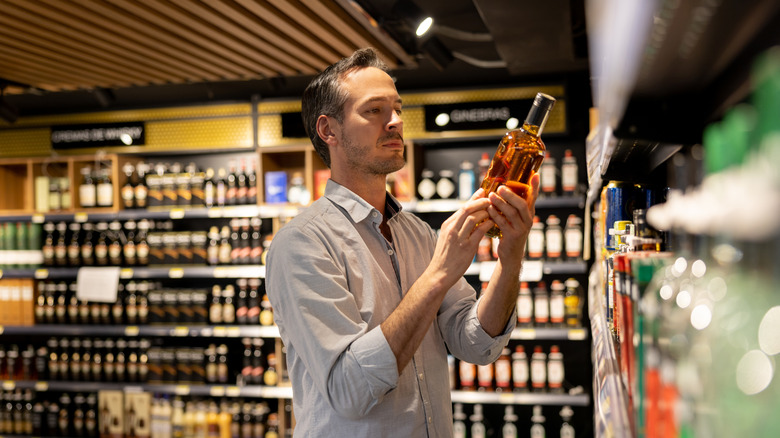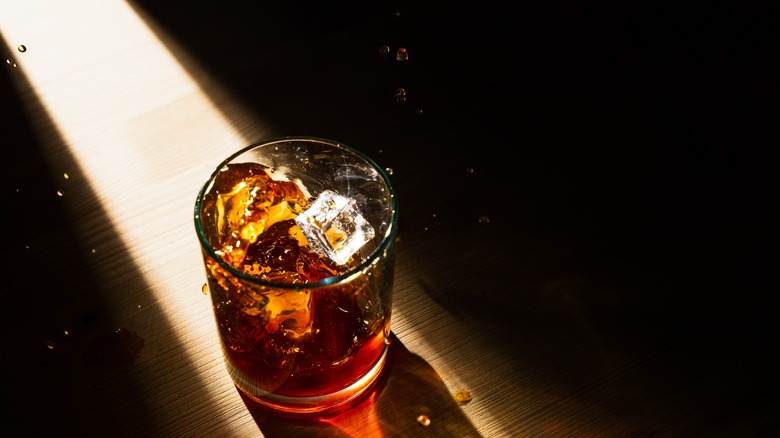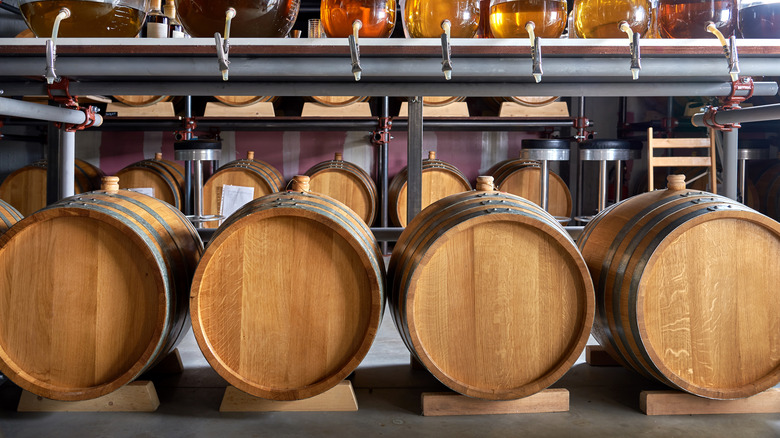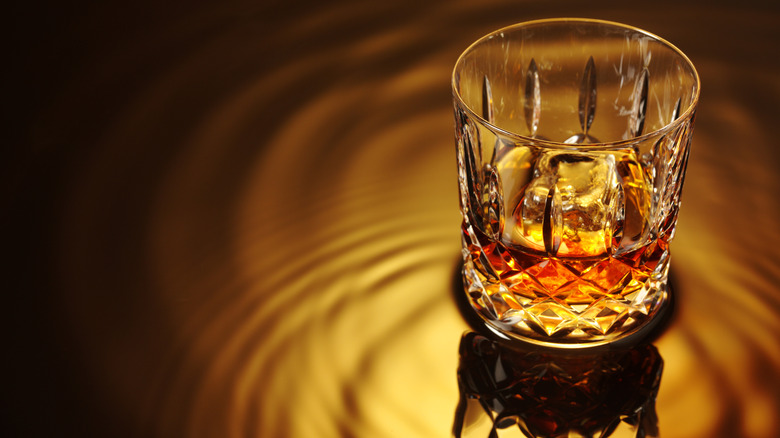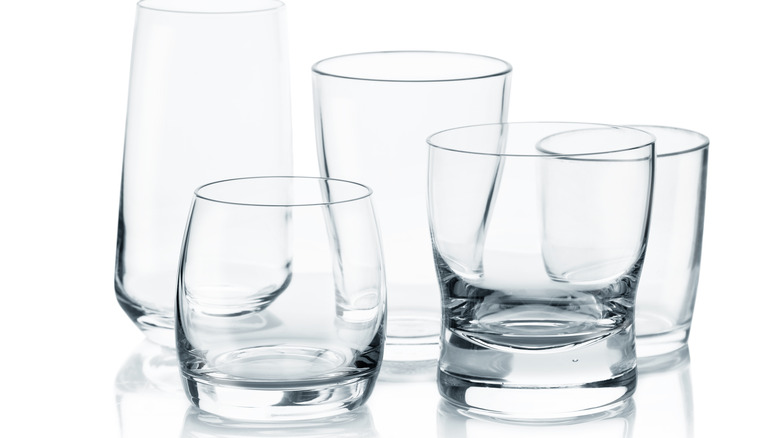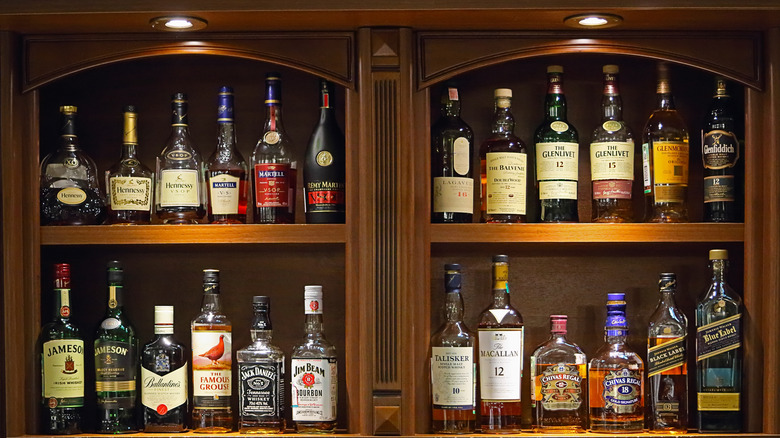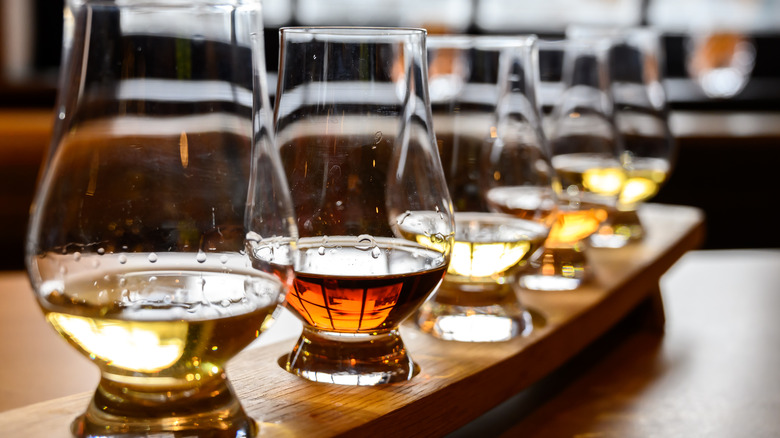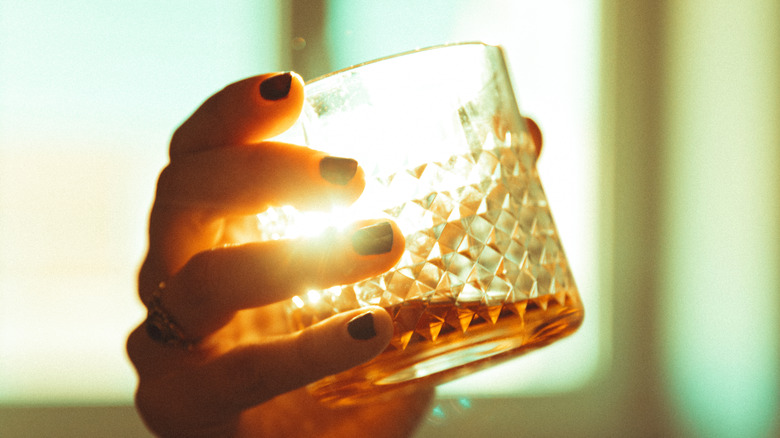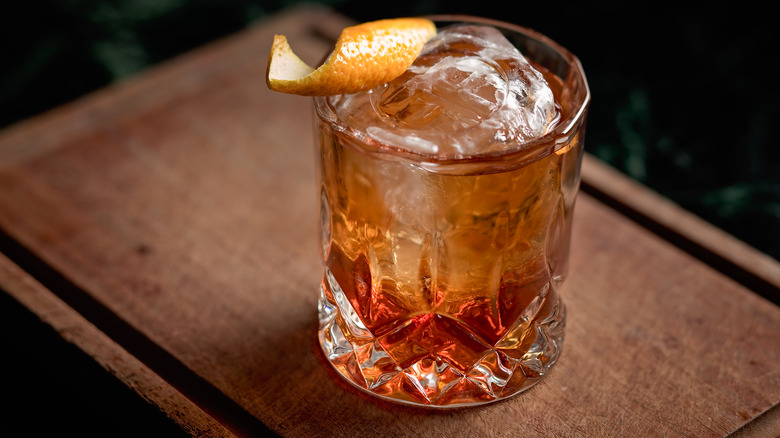10 Crucial Tips On How You Should Be Drinking Bourbon
Bourbon is a delicious, all-American spirit found in a wide variety of styles, able to be imbibed in a multitude of ways. But while it's tempting sometimes to throw back the occasional shot of well bourbon or mindlessly pour a glass of whatever is lying around after a long day of work, it's important to also strive to be more informed, intentional drinkers. Having a few tips and tricks at the ready helps anyone enjoy bourbon to its fullest, most delicious extent.
Not only does understanding how to drink bourbon correctly make the overall drinking experience more enjoyable, but it can also help avoid costly, disappointing mistakes when in the market for a new bottle (or a drink at the bar). Striving to become a better bourbon drinker opens the eyes to new variations, teaches volumes on a fascinating production process, and makes a person the go-to expert for friends and family turn the next time everyone is out for drinks.
Look at the label
They say never judge a book by its cover, but you should (sort of) judge a bottle of bourbon by its label. Now, let's be clear — we aren't talking about the logo, font, design, or any other aesthetic factor. We're talking about the wealth of information you can find about a specific bourbon right there on the bottle, before even taking a sip.
Giving the label a thorough read-through allows you to discover crucial information about a bottle, such as how long it's been aged, where it was made, and what percent ABV it contains. Some bottles include more in-depth information like tasting notes, aromas, and brand history, but even just knowing which state a bourbon was made in (the idea that all bourbon is made in Kentucky is one bourbon myth you need to stop believing) can tell someone a lot about what to anticipate.
When at the local liquor store, do a quick scan of the bottles you're interested in, as well as the bottles you actually plan to purchase. This way, when you're at a bar with a robust selection of bourbons on offer, you'll be able to make a more well-informed decision. In the age of smart phones, Google, and endless information, it's easy to forget that sometimes the most useful information is right in front of your eyes.
Learn key terms
Looking at the label will get you even further if you brush up on a few key bourbon-related terms before selecting a bottle. For example, if you know what single barrel bourbon is, you'll understand why a bottle of single barrel bourbon can have a price tag in the triple digits. From there, you can move on to learning about the difference between single and double barrel bourbon, the difference between single barrel vs. small batch bourbon, and so on.
Understanding the basics will do more than just help you sound like you know what you're talking about. Having a good grasp on terms like bottled-in-bond, cask strength, and finished will help you find the bottles you love, and prevent you from accidentally selecting one that features characteristics you aren't crazy about. While it's not as fun as researching bourbon by drinking it, it will help you overall. Make flashcards, create notes on your phone, search the internet, or flip through a book as you embark on your educational journey. Make your research as basic or as involved as you want, and there's no limit to how much of a self-taught expert you can become.
Don't forget: You can always pour yourself a glass to savor while you learn.
Research different distillers
This is another tip that might feel a bit like homework, but it's worth it. Taking the time to research the distiller provides insight you wouldn't have otherwise. Look into things like their signature production methods, brand history, and general philosophy and ethos. Some distillers focus on innovation, others stick to tradition. Some release new varieties of bourbon every year, others just offer a few classics. Be sure to research local bourbon distillers in your state or city, since it's often more interesting to read about brands that are (literally) close to home.
You might be surprised to learn that a lot of your favorite brands are part of a larger brand family. For example, you might think that Jim Beam, Maker's Mark, and Basil Hayden are separate, competing companies, when in reality they are owned by a single, larger brand called Beam Suntory. Once you start researching, you'll discover how complex the world of bourbon really is, and start to appreciate the art of making spirits on a deeper level. If you have guests over and offer them a glass of bourbon, you'll be able to helpfully, intelligently answer questions they may have about the distiller.
Experiment with dilution
Water is a friend when it comes to drinking bourbon. At some point, you've likely had someone tell you the only way to enjoy any type of whiskey is neat or straight on the rocks. Feel free to disregard that person.
Dilution does not mean watering down your bourbon to the point where flavor is sacrificed. The right amount of dilution actually opens up the flavor in the dram, eliciting tasting notes otherwise might not be found. Dilution also tempers the "hot" taste of bourbon, helping it go down a little smoother.
The next time you're in the mood for bourbon, try drinking it on the rocks with a small splash of water. A little goes a long way, and remember that you can always add more water, but you can't take it out — so err on the side of caution. You should also keep in mind that your ice will also add water, so don't be too heavy-handed. If you like a little effervescence, consider adding a splash of soda water instead. It's the perfect way to make bourbon more refreshing without covering up the flavor.
Use high-quality ice
Dilution is your friend, until it's not. Bad ice will water down your bourbon too quickly, so opt for a big ice cube if you enjoy your dram on the rocks. A large cube is also a great way to elevate a spirit-forward, bourbon-centric cocktail like an Old Fashioned. You can find ice cube molds in all shapes and sizes, and they also make a solid gift for the whiskey-lovers in your life. Once you start paying attention to the kind of ice in your glass, you won't ever take a good cube for granted again.
If you don't have a large ice cube on hand, just be mindful of how much regular ice you're adding to your glass. A few cubes will usually do the trick. If all that's available is crushed ice, either drink the bourbon neat or use it in a cocktail like a Mint Julep, which benefits from the extra dilution. Essentially, all that's necessary to remember is that the smaller the ice, the more it's going to melt — so choose your cube wisely.
Invest in good glassware
It's easy to think all a glass needs to do is provide a physical vessel for the bourbon — but that's actually not the case. There's a lot more science involved in the glassware than many realize, and it pays to invest in the good stuff.
Thankfully, good doesn't have to mean expensive; to enjoy bourbon correctly, just drink it out of glasses that are the correct shape, size, and material. First of all, please don't drink bourbon out of plastic cups (this rule doesn't apply if you're at a barbecue, picnic, etc.), because plastic can alter the flavor of the drink, as well as provide the drinker with less control over the temperature of the beverage.
The next thing to pay attention to is the shape of the glass. If drinking bourbon neat, go with a snifter. If taking it on the rocks, opt for a (you guessed it) rocks glass. Finally, pay attention to the size of the glass. Volume can be incredibly deceiving, and when free pouring a drink at home, it's easy to over-pour in a glass that's too large. Even shot glasses that look like a "single" can actually contain three or four ounces, so if uncertain, always measure with a jigger or measuring cup.
Store it correctly
Unlike vodka, bourbon doesn't belong in the freezer. Never store bourbon in the fridge, in a hot room, or in direct sunlight. Storing bourbon correctly, however, will help preserve the integrity of the flavors and allow consumption at the right temperature. Keeping bourbon in a temperature-controlled area, like a liquor cabinet or bar cart that's not in the sun, is the way to go.
Fortunately, bourbon doesn't go bad when it's stored correctly; you have all the time in the world. Unlike wine, which continues to age and change in the bottle, the flavors in bourbon won't change over time. Grow a collection as the years go by, without concern of unwanted changes, as long as you take care of your bottles. If you really get into bourbon, chances are you're going to want to display your collection, which is another reason why you should pay attention to storage.
Visit a distillery
Seeing the production process in action teaches a lot. Most distilleries offer guided tours, where they'll teach you about how they make bourbon, as well as about the nuances of each of their offerings. If you're not keen on doing research on your own, this is a great way to get the information you need in a fun, interactive way. As an added bonus, you can also ask questions and connect with other like-minded bourbon enthusiasts.
Visiting a distillery is a fun way to spend an afternoon, and most tours come complete with a tasting experience, too. You can sample flights, participate in guided tastings, and pick up a bottle of whichever dram was your favorite. This means you'll get to learn about bourbon both in theory and in practice, which will put you on the fast track to becoming an informed drinker who knows how to enjoy bourbon correctly. If you don't have any distilleries in your area, there's nothing wrong with booking your next vacation based on distilleries you'd like to visit. After all, we hear Kentucky is lovely this time of year.
Don't be afraid to experiment
A lot of bourbon drinkers get stuck in a rut. They know what they like, and stick with it. While there's nothing wrong with having a go-to, it's important to branch out and try a different style or brand of bourbon than usual. One of the best things about bourbon is that there is a lot of variation between different bottles — and you're missing out if you aren't making an effort to see what's out there. For example, some bourbons contain a lot of rye in the mashbill, while others contain high levels of wheat. The flavor differences between these two styles are very noticeable, so it's worth making sure you try both to see which one you prefer.
You can also experiment with the way in which you're drinking your bourbon. If you don't love one bottle neat, try it on the rocks. If you always drink your bourbon with soda water, try it sans the bubbly stuff. Experimenting can make all the difference in the world, and it's the only way to really advance your bourbon knowledge. Plus, what's the worst that can happen? At the end of the day, you're still drinking bourbon.
Don't use a straw for Old Fashioneds
If your favorite way to enjoy bourbon is in an Old Fashioned, please don't use a straw. This isn't about the environmental impact (you should really be using paper straws, anyway) or trying to look "cool." It's actually about flavor.
You'll miss out on a lot of the aromas in an Old Fashioned when you use a straw, and since your sense of smell is directly linked to how you perceive flavor, you'll sacrifice the overall taste of the beverage. Old Fashioneds are made by expressing an orange peel over the surface of the drink as the finishing touch, which you'll notice a lot on the nose. Using a straw won't allow you to enjoy those (much-needed) citrusy notes.
If you order an Old Fashioned at a restaurant, dive bar, or anywhere that's not super cocktail-focused, there's a good chance you'll receive your drink with a straw. Just quietly put it to the side and rejoice in the fact that your bourbon knowledge is on point. And we're begging you: Please don't say anything to the bartender — there's no beverage in the world that's important enough to embarrass someone or make yourself look like a know-it-all.

